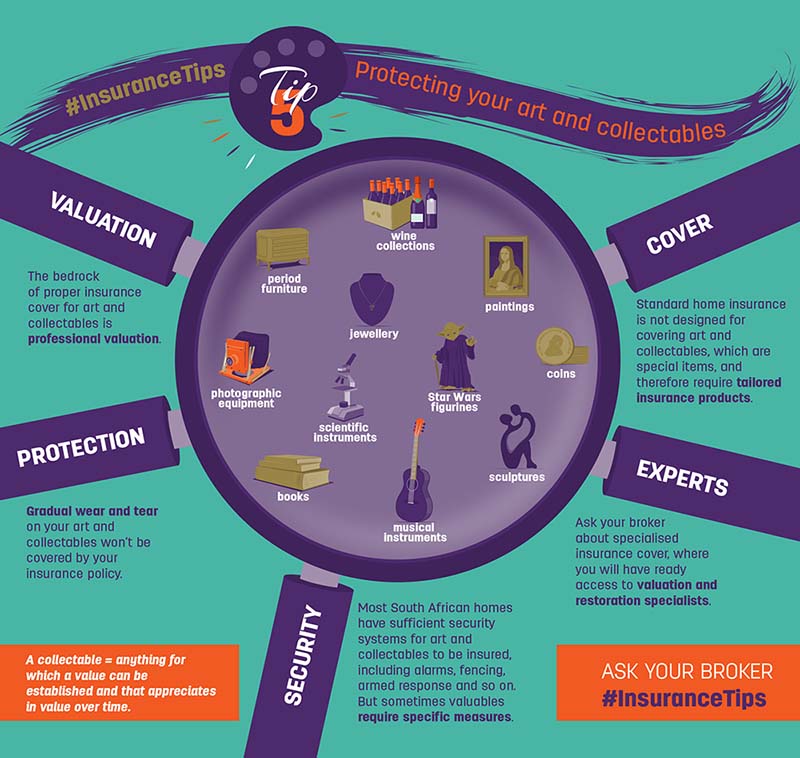
Forget about sensational stories of ignorant or wilful damage, like the one about the Irma Stern masterpiece used as a message board, or the KwaZulu-Natal art gallery flooded by protesting municipal workers. Risk constantly hangs over art and collectable items, and they need special care – and specific insurance cover.
Unlike most things we buy, which immediately depreciate in value, artwork and collectables only become more valuable over time.
You don’t need to dabble in European or American art to play in the big leagues. African art has rapidly become highly sought after and works by artists such as Nigeria’s Njideka Akunyili Crosby, South Africa’s Marlene Dumas and Ethiopia’s Julie Mehretu fetch millions of dollars. You may even possess such valuable artwork, and not even realise it …
An enormous variety of items meet the definitions of “art” and “collectable”, including paintings, statues, sculptures, jewellery, metalware, militaria, musical instruments, books, carpets, antiques and period furniture, wine and whisky collections, toys, precious metals, coins, scientific instruments, photographic equipment, stamp collections, and sporting and political memorabilia, among many others.
Essentially, anything that’s collectable, for which a value can be established and that appreciates in value over time, fits the bill.
But while some of us collect things as an investment, many of us do so for their beauty or rarity. Either way, they must be properly and expertly insured, because damage or loss can be financially disastrous.
If you’re a collector, your biggest risk isn’t theft; it’s accidental damage. Objects are dropped and paintings are torn or get wet, for example, which immediately affects their value even if they can be restored.
Thus protection is both in the physical sense and in terms of insurance, because theft, water damage, ill-advised cleaning, slipshod transportation and storage, and even butterfingers can turn items worth millions into bric-a-brac.
So how do you ensure that your art or collectables are properly covered? You should...
...Have your items professionally valued
The bedrock of proper insurance cover for art and collectables is professional valuation. You should get recognised experts to examine your items to ensure that they are the real thing (i.e. not forgeries or copies), and assign an accurate value to them.
That valuation plays a fundamental role in determining your insurance premium and, of course, what you will be paid out in the event of a claim. It is thus very important to have your valuables appraised regularly.
… Protect them appropriately
Climate control is critical for safeguarding your assets and their value, for one simple reason: gradual wear and tear won’t be covered by your insurance policy.
If you collect photographs, for example, you have a choice: carefully pack them away, and then no one ever sees them, or frame them and hang them on your walls. But photographs and other paper-based artworks tend to discolour and become fragile over time, so you should use museum-standard glass to protect them from the ravages of ultraviolet light.
You should take care around light generally: even bounced light – that which reflects off surfaces – can cause damage to artworks.
You should also bear in mind whether or not your fire-prevention measures are appropriate. So, for example, a sprinkler system will play havoc with items that should never get wet, such as paintings. In that case, a gaseous fire suppression system can smother a blaze without further damaging artwork.
Should you need to repair or restore a valuable item, ensure that you engage a professional restorer to do the work.
… Put in place appropriate security measures
Most South African homes have sufficient security systems for art and collectables to be insured, including alarms, fencing, armed response and so on. But sometimes valuables require specific measures.
Truth be told, thieves may not always notice that William Kentridge print in your lounge as they go for your flat-screen TV set. But they will be tempted by your coin collection – more likely for melting it down than for the value of the coins themselves.
So while your Kentridge is most probably safe hanging on the wall, you should keep coins in a floor- or wall-mounted safe that is strong and hidden.
… Have the right cover
Standard home insurance is not designed to cover art and collectables, which are special items and therefore require tailored insurance products.
Your insurance should at least cover you for accidental damage and theft of your valuable art or collectables. But think about when such valuables are not under your roof, such as when they are in transit or storage – if you aren’t covered in these circumstances, ensure that you add policy extensions where and when relevant.
… Go with the insurance experts
Ask your broker about specialised insurance cover, where you will have ready access to valuation and restoration specialists.